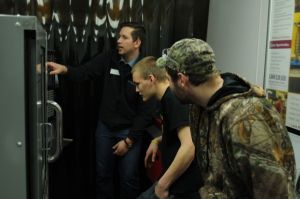
Andrew Kott is the “perfect technician” to teach rural high school students about automated warehouses and supply chain technologies, according to Shamus Funk.
As principal investigator of the Smart Manufacturing and Resources for Transforming the Future (SMART Future) project, Funk hired Kott to teach students and to work with high school teachers in Chippewa Valley Technical College’s Mobile Manufacturing Lab.
“Students respond well to him,” Funk said, citing Kott’s youth, energy, and knowledge. Kott worked in industry after earning a two-year machine tooling diploma at Chippewa Valley Technical College in 2012. He’s currently taking courses to earn a bachelor’s degree in education.
Laughing modestly about the compliment, Kott said, “I enjoy what I’m doing; I’m enjoying sharing this information with the students and seeing them grow.” He credits the students’ engagement to the mobile lab’s “cool equipment.” For the SMART Future project the lab has been equipped with robotic industrial arms, a CNC vertical mill, a laser engraver, laptop computers, and a small-scale simulation of an automated distribution center.
The project’s goals for the high school students include having them demonstrate mastery in automation, networking, programming, and supply chain technologies to qualify for industry certifications and/or college credits. The project’s other ambitious goals include devising a sustainable system to gauge its impact on students’ career paths.
Funk, a chemistry instructor at Chippewa Valley Technical College (CVTC) in Eau Claire, Wisconsin, leads the Advanced Technological Education project (DUE #1700535) that builds on the college’s previous use of an ATE grant—Advancing Manufacturing through Applied STEM Education (DUE #1304103)—to test innovative machining and welding instruction in the mobile lab.
One of the biggest lessons that Funk learned during the Advancing Manufacturing project is “that it is unrealistic to provide five days of training for a high school instructor and say, ‘Go ahead. You’ve got this trailer for nine weeks. Do what you can.’ It just doesn’t work that way. We need to have a closer connection for that to really work.”
Partnering with High School Teachers
So the SMART Future grant employs Kott to work in tandem with the teachers at four rural high schools. He either leads lessons or assists the teachers depending on the topic and the number of students who are working toward adding a particular industry credential or college credit to their portfolios. The teachers receive professional development from CVTC faculty in addition to coaching from Kott while he is at their schools. Kott also answers teachers’ questions by phone and email, and uses a microsite to facilitate learning among all the teachers.
Kyle Danzinger, a tech ed teacher at Durand High School, explained that both he and his students have benefitted from Kott’s knowledge and the extra equipment that comes with mobile lab. He pointed out that neither he nor his students had seen a laser engraver prior to the lab’s visit during the third quarter of the 2017-2018 academic year.
He thinks students benefit from the lower student-teacher ratio for the lessons that he and Kott worked out. “Students were with me learning about how small engines work while the other half of students learned how to use a digital multimeter [with Kott]. When we were done delivering the information we needed, we switched groups of students and my students went to Andy [Kott] and the students who were with Andy [Kott] came to me,” Danzinger wrote in an email.
The project will use curriculum from the National Center for Supply Chain Automation for modules that teach Industry 4.0 concepts such as how electro-mechanical and cyber-physical systems interact in advanced manufacturing workplaces and massive distribution centers.
Collaborating with Industry
The Smart Future project’s industry partners include 3M, Ashley Furniture Industries, Rockwell Automation Inc., Fanuc America Corporation, and Grassland Dairy Products, Inc. The employers’ feedback has influenced both the professional development for the teachers and the curriculum for the high school students. The ATE project has also led to additional industry support.
In August, 3M gave $133,200 to CVTC Foundation, Inc., to purchase programmable logic control (PLC) equipment valued at $90,000 for the four high schools participating in the Smart Future project, to support educators’ professional development, and to develop career mentor partnerships, internships and career exploration opportunities with area manufacturing businesses.
“3M has identified performance expectations and enduring understandings regarding the application of PLCs in the classroom,” Jeff Sullivan, CVTC dean of manufacturing, wrote in an email announcing 3M’s donation to project stakeholders. “In addition these PLC’s will be able to interface with our Mec Labs, also purchased by 3M, to give our students in Menomonie, Durand, Owen-Withee, and Greenwood [high schools] the experience of automating and controlling a system.”
“We try to respond to industry,” Funk said during a phone interview, adding, “At the same time [we] try to push the high school instructors a little bit out of their comfort zones.” He explained that offering three sections of woods may be what an instructor knows and does well, but it may not hold students’ attention or fit what they will need to succeed as technicians.
“If we can push them to try to add automation into their programs or add 3-D printing into one of their courses, hopefully, hopefully, the students will respond a little better to that and hopefully the instructors will be encouraged to push themselves a little bit,” Funk said.

 Subscribe
Subscribe


 See More ATE Impacts
See More ATE Impacts

Comments
There are no comments yet for this entry. Please Log In to post one.